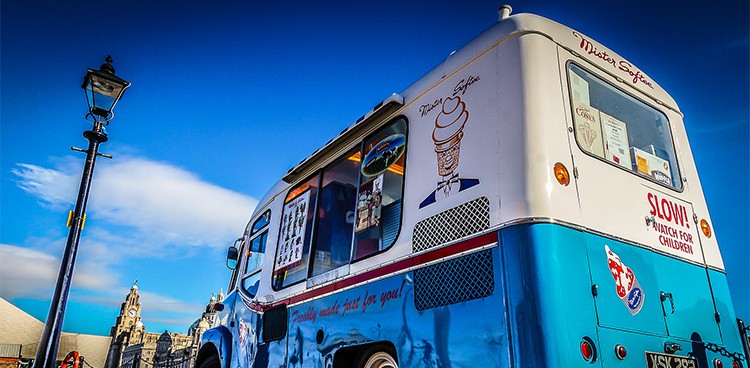
Nothing conjures up childhood nostalgia more than the signature tinkles of ice cream truck jingles wafting their way through the air on a steamy summer day. I grew up with Good Humor Trucks, but many others may feel pulls on their heart strings when they catch wind of the proprietary Mister Softee jingle. Eater’s recent piece on Mister Softee might be just as sweet as the ice cream it serves.
The Mister Softee franchise was the brain child of the Brothers Conway, two entrepreneurial technicians who worked for Sweden Freezer, a large ice cream machine manufacturer. When they noticed that many customers were buying the company’s machines to use on trucks, and that this jerry-rigging would often lead to multiple repair requests due to the lack of shock absorbers and other necessary modifications, they went to the company with the idea of a separate division to service and supply ice cream trucks. But Sweden Freezer didn’t get it, and passed on the offer, so the Conways left to start their own outfit. With money borrowed from their uncle, a jingle written by Les Waas, and a yellow, red, white, and blue logo of a man with a cone face and soft-serve hat, Mister Softee was born. The first truck debuted on St. Patrick’s Day and (aptly) sold green ice cream to West Philadelphia customers.
The company soon became a part of the American dream. In its heyday of the 1960s, there were 1,000 trucks in 15 states servicing soft-serve-seekers. (This number has declined to about 650 trucks today). The first wave of franchisees were Irish, Italian, and Greek immigrants, but in later years Caribbean immigrants, African-Americans, and Puerto Ricans have invested and driven trucks. These franchisees have learned to cater to their markets. In Pennylvania, the trucks serve a higher butter fat ice cream, while Southern consumers prefer the sweeter, lower fat formula of the soft serve.
As Brooklyn franchisee Shevonne Guishard-Lambert, who works 11-hour days, explained to Eater, selling ice cream can be pretty touch and go: “It’s like going fishing. Sometimes you catch something, and sometimes you don’t, but you always have to go out.” On some less affluent blocks, she sells cones for as little as $1 so that her customers can afford the sweet treat. One regular “$40 block” for her dried up as an income source when the man who used to buy ice cream for the block was arrested for selling drugs. While drivers in Manhattan are able to charge between $2 and $3 a cone, the tradeoff is that they have to contend with hydrant tickets. But despite all the challenges and the long hours, there are rewards. As Bronx franchisee José Rivera told Forbes, “Mister Softee’s become a tradition. And generation from generation from generation, their kids bring their kids, and we’re all on the streets every day. And they love us.”
Feature Photo Credit: “Mister Softee” by Beverley Goodwin | CC



